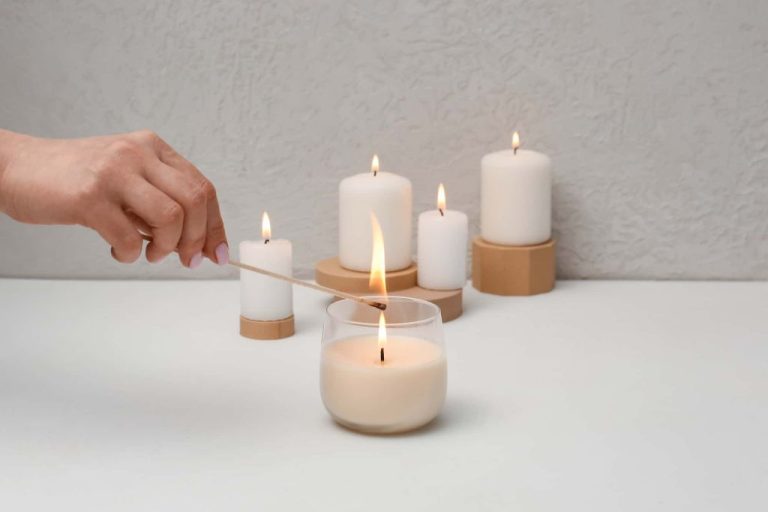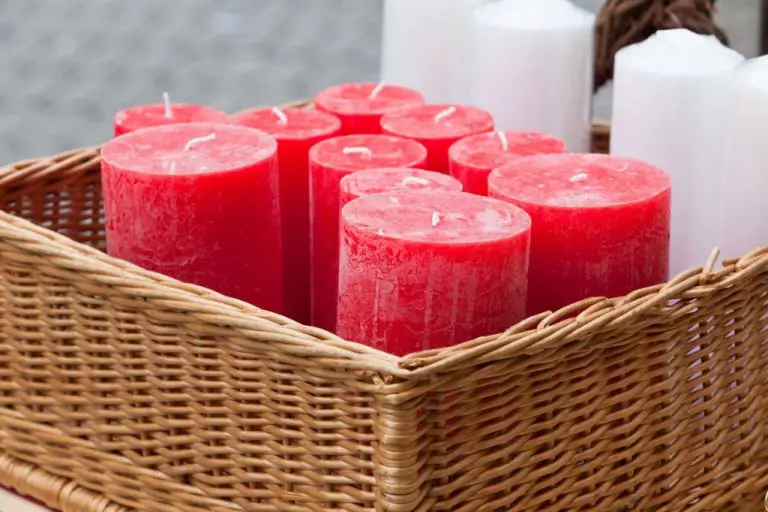How Do You Stand Up Long Candles?
How to Stand Up Tall Candles Securely and Safely
Burning candles helps set a mood with soft lighting and pleasant aromas. However, tall taper candles present a challenge for standing them up properly so they don’t fall over. This guide will cover tips and techniques to securely stand tall candles in order to burn them safely without any accidental tipping.
The goal is to prevent tall candles from falling over while they burn, which could lead to fire hazards or messy wax spills. We’ll discuss assessing the candle and holder materials, adjusting the base size and shape, using non-tip candle designs, adding weight, anchoring with adhesives, placement on non-flammable surfaces, avoiding drafts, and monitoring lit candles.
Assess Candle and Holder
When considering how to stand up a tall candle, first take stock of the candle’s size, shape, and weight. Measure the candle’s height and diameter. A slim taper candle may be top heavy and prone to tipping over. A thick pillar candle has a lower center of gravity that helps it stand upright. Also check the weight. Heavier candles are less likely to topple than lighter ones.
Next, examine the candle holder carefully. Pay attention to the opening size, depth and material. Glass, metal or ceramic holders often have wide, sturdy bases to securely hold candles. Check that the holder opening snugly accommodates the candle’s thickness. A loose fit allows a candle to lean and fall over. The holder depth should exceed the candle’s height for stability. Shallow holders do not anchor candles well.
Finally, consider the candle and holder materials together. Smooth, straight-sided candles slip easily in glass or metal holders. Wax with more friction, like a natural soy candle, grips the holder better. Assess if the candle and holder pairing is top heavy or bottom heavy. An unbalanced setup takes more effort to stand up.
Material Considerations
The material that your candle holder is made from can impact its stability. Here are some pros and cons of common candle holder materials:
Glass – Glass holders allow the candlelight to shine through attractively, but glass can be slippery and prone to tipping. Look for glass holders with wide, flat bases for stability.
Metal – Metal like iron or steel makes very sturdy holders that are difficult to tip. However, metal conducts heat, so make sure to use a buffer like sand or pebbles in the base of the holder.
Wood – Wood holders complement natural candle styles well. Unfinished wood provides grip to resist tipping. Be mindful of fire safety, avoiding very thin or dried out wood.
Ceramic – Glazed ceramic holders are attractive but can be slippery like glass. Unglazed terra cotta provides an earthy feel and texture to grip onto surfaces better.
Consider the weight, base width, balance, and texture of the candle holder material to find the most stable option for your needs.
Base Size and Shape
When selecting candle holders for tall candles, opt for wide, flat bottoms whenever possible. The broader the base, the more stable the candle will be. A wide, flat foundation distributes the candle’s weight evenly and lowers its center of gravity. This makes the assembly much harder to tip over. On the other hand, tall, narrow bases concentrate a candle’s weight in a smaller area. This raises the center of gravity and makes tipping more likely. Look for candle holders with bases at least as wide as the candle itself. Or choose holders with heavy weighted bottoms to lower the center of gravity. Wider bases also allow you to place candles closer together without risk of them toppling into each other.
Use Non-Tip Designs
When choosing a holder for tall candles, opt for non-tip designs that provide stability. There are several types of non-tip holders to consider:
Cup Holders: Cup holders grasp the base of the candle, encircling it in a cup shape. The cup provides a wide, flat base that prevents tipping. Look for cup holders made of heat-safe materials like glass, ceramic or metal.
Clamp Holders: Clamp holders secure candles by clamping onto the base. The clamping mechanism holds the candle upright. Clamps allow for adjustable sizing to accommodate different candle diameters. Clamp holders are typically made of metal.
Spike Holders: Spike holders contain sharp pins or spikes that pierce the bottom of the candle to hold it in place. The spikes anchor the candle and prevent tipping. Make sure to use spike holders specifically designed for candles with wick holes so as not to damage the wick.
Choosing non-tip cup, clamp or spike holders provides a sturdy, balanced base for tall candles. This prevents tipping which can lead to big messes and potential fire hazards.
Add Weight
One of the most effective ways to keep tall candles standing upright is to add weight to the base. This lowers the candle’s center of gravity and makes it much more stable. Some common items you can use to weigh down candle holders include:
- Pebbles – Add a few pebbles to the bottom of a candle holder before inserting the candle. The extra weight will anchor it in place. Pebbles can be purchased at most craft stores.
- Beads – Glass beads work the same way as pebbles to add stability. Pour some beads into the holder. Make sure they completely surround the bottom 1-2 inches of the candle.
- Sand – Fine sand like playground sand is another option. Pour a couple tablespoons into the holder. The granules will shift to keep the candle steady.
When adding any weighting material, start with just a small amount. You don’t need much to make a difference. Too much weight could become top heavy and cause new issues. Monitor weighted candles closely the first few times burning.
Anchor with Adhesives
If the candle holder’s base is smooth, you can anchor candles in place with small amounts of adhesive putties or waxes. These temporary bonding solutions provide friction against smooth holders to prevent sliding while allowing for clean removal later.
Museum wax, also called Quake Hold, is commonly used to keep objects and artwork securely in place. Simply pinch off a pea-sized amount and roll it into a small ball between your fingers. Press it onto the bottom center of the candle, then firmly place the candle into the holder so the wax adheres them together.
Similarly, poster putty or reusable adhesive putties can be rolled into mini balls and used to anchor candles. Press the putty onto the flat bottom of the candle, then apply in the holder. These are excellent for use in glass holders, where they can provide grip against slippery surfaces.
When using any adhesive putty or wax, be sure to place just a small amount. You want sufficient sticking power but easy removability. Always check the product instructions and do not exceed the heat recommendations.
Place on Non-Flammable Surface
When selecting a surface to place a tall candle on, it’s important to choose a non-flammable material. The best options for candle bases include stone, metal, and glass. These materials are fire-resistant and minimize the risk of starting an accidental fire.
Stone surfaces like granite, marble, or slate make excellent candle holders. The stone is able to absorb and dissipate heat well. Just be sure the stone is level and smooth so the candle sits securely.
Metal surfaces are also ideal for candles. Try an iron, steel, or aluminum candle holder or base. The metal conducts heat away from the flame. Wrought iron designs can anchor candles in an aesthetic way.
Glass holder and candleplates are beautiful and functional. Glass withstands high temperatures and resists catching fire. Clear glass allows the candlelight to shine through. Look for thick, sturdy glass products to prevent tipping.
Avoid setting candles directly on wood, plastic, or other flammable surfaces. The flame can heat up these materials and increase fire risk. Choose non-flammable stone, metal, or glass surfaces to safely contain the candle.
Avoid Drafts
One way to keep tall candles from falling over is to avoid drafts around the candle. Things like air vents, fans, and open windows can create air currents that may be strong enough to tip over a tall or top-heavy candle.
When burning tall candles, make sure to close or redirect any vents pointing toward the candle. Turn off ceiling fans and close windows to block drafts in the room. Avoid placing the candle near frequently opened doors that let in gusts of air each time.
Shielding the candle from direct air currents removes an external factor that can contribute to the candle falling over. This allows you to better monitor and manage the stability of the candle itself.
Monitor Candles
One of the most important things when burning long candles is to never leave them unattended. Candles should always be monitored while lit to avoid potential fire hazards. If you need to leave the room or go to sleep, be sure to extinguish the candle first.
Check on candles frequently to make sure they are burning properly and not getting too close to the end. Trim wicks as needed to help prevent irregular burning and excessive dripping. Watch for signs of candles tunneling or flaring which can be dangerous.
Stay alert to any potential issues like tipping, drafts, proximity to flammable materials, etc. It only takes a moment for a candle accident to occur, so remain vigilant. Appoint someone to be in charge of monitoring candle safety if you have multiple candles burning or are hosting an event.
With proper precautions, long candles can burn safely. But they always require an attentive eye when lit. Never leave burning candles unattended even for a short period. Take candle safety seriously and exercise caution to enjoy long candles responsibly.




